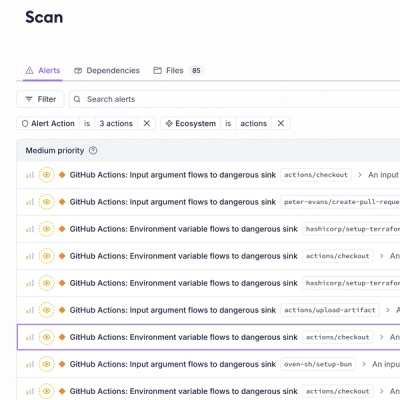
Product
Introducing Socket Firewall Enterprise: Flexible, Configurable Protection for Modern Package Ecosystems
Socket Firewall Enterprise is now available with flexible deployment, configurable policies, and expanded language support.
The command-line interface framework for TypeScript, fully tested with baseman.
tsconfig.json
target needs to be set as 'es6' / 'es2015' or higher.experimentalDecorators and emitDecoratorMetadata should both be enabled.yarn add clime
# or
npm install clime --save
Here is a basic example, an entry file (usually won't change much among time) and a single command:
src/cli.ts
#!/usr/bin/env node
import * as Path from 'path';
import {CLI, Shim} from 'clime';
// The second parameter is the path to folder that contains command modules.
let cli = new CLI('greet', Path.join(__dirname, 'commands'));
// Clime in its core provides an object-based command-line infrastructure.
// To have it work as a common CLI, a shim needs to be applied:
let shim = new Shim(cli);
shim.execute(process.argv);
src/commands/default.ts
import {Command, command, param} from 'clime';
@command({
description: 'This is a command for printing a greeting message',
})
export default class extends Command {
execute(
@param({
description: 'Your loud name',
required: true,
})
name: string,
) {
return `Hello, ${name}!`;
}
}
Clime provides a way in which you can get parameters and options you really want to: typed at compile time and casted at run time.
import {Command, Options, command, option, param, params} from 'clime';
export class SomeOptions extends Options {
@option({
flag: 't',
description: 'timeout that does nothing',
})
timeout: number;
// You can also create methods and properties.
get timeoutInSeconds(): number {
return this.timeout / 1000;
}
}
@command()
export default class extends Command {
execute(
@param({
required: true,
description: 'required parameter foo',
})
foo: string,
@param({
description: 'optional parameter bar',
})
bar: number,
@params({
type: String,
description: 'extra parameters',
})
args: string[],
options: SomeOptions,
) {
return 'Hello, Clime!';
}
}
And this is what you get for usage/help information:
USAGE
command <foo> [bar] [...args] [...options]
foo - required parameter foo
bar - optional parameter bar
args - extra parameters
OPTIONS
-t, --timeout <timeout> - timeout that does nothing
Clime will automatically cast parameters to number, boolean based on their types.
It also defines interface StringCastable that allows user-defined classes to be casted from parameters.
Please note that
StringCastableis correspondent to the type of constructor instead of instance, so noimplementsshould be present.
For example:
import {CastingContext} from 'clime';
class File {
constructor(public path: string) {}
static cast(path: string, context: CastingContext<File>): File {
return new File(Path.resolve(context.cwd, path));
}
}
A validator or validators can be specified for parameters and options validation.
A validator can either be an instance that implements interface Validator<T>, a function that matches type ValidatorFunction<T> or a regular expression.
For the validators in forms other than regular expression, it is the casted value that will be tested against. And for regular expression validator, the source string will be tested against instead.
A useful way to distinguish expected errors (e.g., errors that might be caused by incorrect user input) from other errors is to throw instances of ExpectedError class or its subclasses.
And a validator for example, usually throw instances of ExpectedError.
As TypeScript only emits metadata for target decorated by decorators, if no command-line parameter added, Clime won't be able to know information of options and context parameter.
Thus a @metadata decorator that does nothing at run time is provided for preserving these metadata:
@command()
export default class extends Command {
@metadata
execute(options: SomeOptions) {
return 'Hello, Clime!';
}
}
It is required to have this @metadata decorator if no other decorator is applied to method execute.
Context is an object contains information like current working directory and commands sequence.
You can have context passed in by adding the last parameter of execute method with type Context:
@command()
export default class extends Command {
@metadata
execute(context: Context) {
return 'Hello, Clime!';
}
}
Clime provides an easy way to create subcommands. The default entry of a clime command is default.js (default.ts before compilation of course).
Any other .js files under the same folder are considered as subcommand files.
Clime allows multi-level subcommands based on file structures. For three-level commands like below:
command
command foo
command foo biu
command foo yo
command bar
command bar bia
command bar pia
The file structure could be:
- commands
- default.ts
- foo.ts
- foo
- biu.ts
- yo.ts
- bar
- default.ts
- bia.ts
- pia.ts
You may notice that the level-n entry could be either at the same level of the level-(n+1) commands with name default.ts (like default.ts in bar),
or at the same level of the folder of level-(n+1) commands (like foo.ts and folder foo).
Clime allows an entry of a group of subcommands to provide only descriptions rather than an actual command.
Just export description and brief directly from the entry module to do so:
export const description = 'Some detailed description';
// Used when listing as subcommands.
export const brief = 'brief description';
subcommands fieldClime has to load every subcommand modules under a specific command to know their briefs.
To avoid this, you may export a subcommands array with subcommand definitions like below:
import {SubcommandDefinition} from 'clime';
export const subcommands: SubcommandDefinition[] = [
{
name: 'foo',
brief: 'A subcommand named foo',
},
{
name: 'bar',
brief: 'A subcommand named bar',
},
];
Further more, those definition entries also allow you to add alias or aliases for subcommands:
import {SubcommandDefinition} from 'clime';
export const subcommands: SubcommandDefinition[] = [
{
name: 'foo',
alias: 'f',
brief: 'A subcommand named foo',
},
{
name: 'bar',
aliases: ['b', 'bb'],
brief: 'A subcommand named bar',
},
];
For some CLI tools, it would be nice to support project specific commands. And Clime has this ability built-in.
For example, you may define the cli object like below to load commands from both CLI tool commands path as well as project path:
let cli = new CLI('greet', [
Path.join(__dirname, 'commands'),
'project-commands',
]);
And you can also add different labels for those command directories:
let cli = new CLI('greet', [
{
label: 'Built-in',
path: Path.join(__dirname, 'commands'),
},
{
label: 'Extra',
path: 'project-commands',
},
]);
As the core of Clime is not coupled with stream-based command line, commands written with Clime can be easily tested.
For example:
import {Command, Context, command, metadata} from 'clime';
export class TestContext extends Context {
promptForQuery(): Promise<string> {
// Using library like Inquirer.js to interact with user.
return Promise.resolve('result');
}
}
@command()
export default class TestCommand extends Command {
@metadata
execute(context: TestContext) {
return context.promptForQuery();
}
}
To test this command, we just need to extend TestContext, override promptForQuery and call execute with new context.
If this command is meant to stop somewhere and exit the process, we can define a ExitSignal class that implements Printable interface:
import {Printable} from 'clime';
export class ExitSignal implements Printable {
constructor(public code: number) {}
print(): void {
process.exit(this.code);
}
}
export function exit(code = 0): void {
throw new ExitSignal(code);
}
Because print method would only be executed by the shim, your test can safely catch the exit signal and assert its correctness.
MIT License.
FAQs
The command-line interface framework for TypeScript.
We found that clime demonstrated a not healthy version release cadence and project activity because the last version was released a year ago. It has 2 open source maintainers collaborating on the project.
Did you know?

Socket for GitHub automatically highlights issues in each pull request and monitors the health of all your open source dependencies. Discover the contents of your packages and block harmful activity before you install or update your dependencies.

Product
Socket Firewall Enterprise is now available with flexible deployment, configurable policies, and expanded language support.

Security News
Open source dashboard CNAPulse tracks CVE Numbering Authorities’ publishing activity, highlighting trends and transparency across the CVE ecosystem.

Product
Detect malware, unsafe data flows, and license issues in GitHub Actions with Socket’s new workflow scanning support.